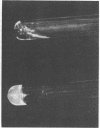Abstract
The Limulus in vitro endotoxin assay was evaluated as a possible method for the prompt detection of significant gram-negative bacteriuria in children. This assay is capable of detecting endotoxin associated with intact cell walls of viable gram-negative bacteria as well as free endotoxin. Quantitative results are obtained following a 1-h incubation of Limulus lysate and 10-fold dilutions of otherwise untreated urine. A standard curve of Limulus activity and viable cell counts of Escherichia coli and Klebsiella pneumoniae in urine demonstrated that a positive Limulus reaction at a dilution of 1:100 or 1:1,000 indicated a colony count of at least 100,000 bacteria/ml. A positive Limulus reaction only from undiluted urine or at a dilution of 1:10 indicated less than 100,000 cells/ml. These experimental observations were confirmed by comparing the Limulus test with quantitative plate counts on 209 urine specimens from a mixed pediatric population. These results indicate that the Limulus assay is a simple, accurate method for rapid presumptive detection of gram-negative bacteriuria in patients where an immediate diagnosis is needed. This test would also seem promising for screening large patient populations for bacteriuria or for monitoring the effectiveness of treatment of urinary tract infections.
Full text
PDF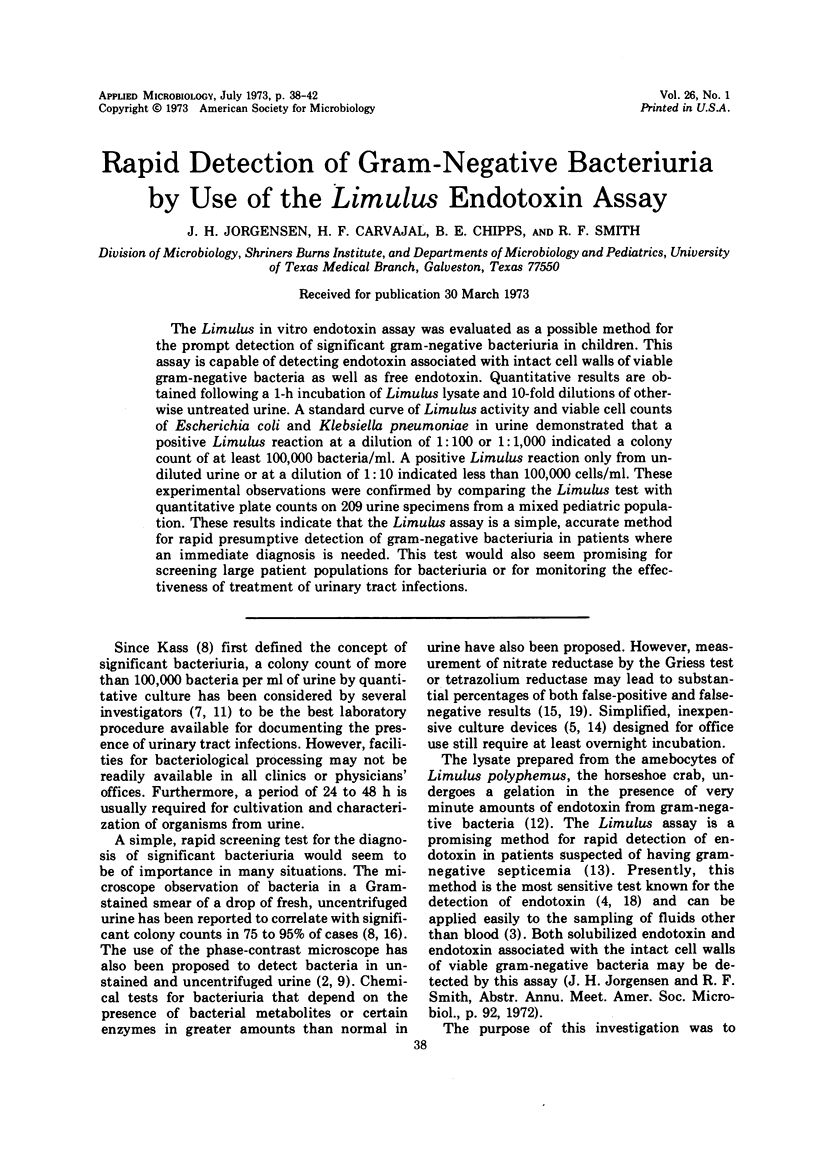
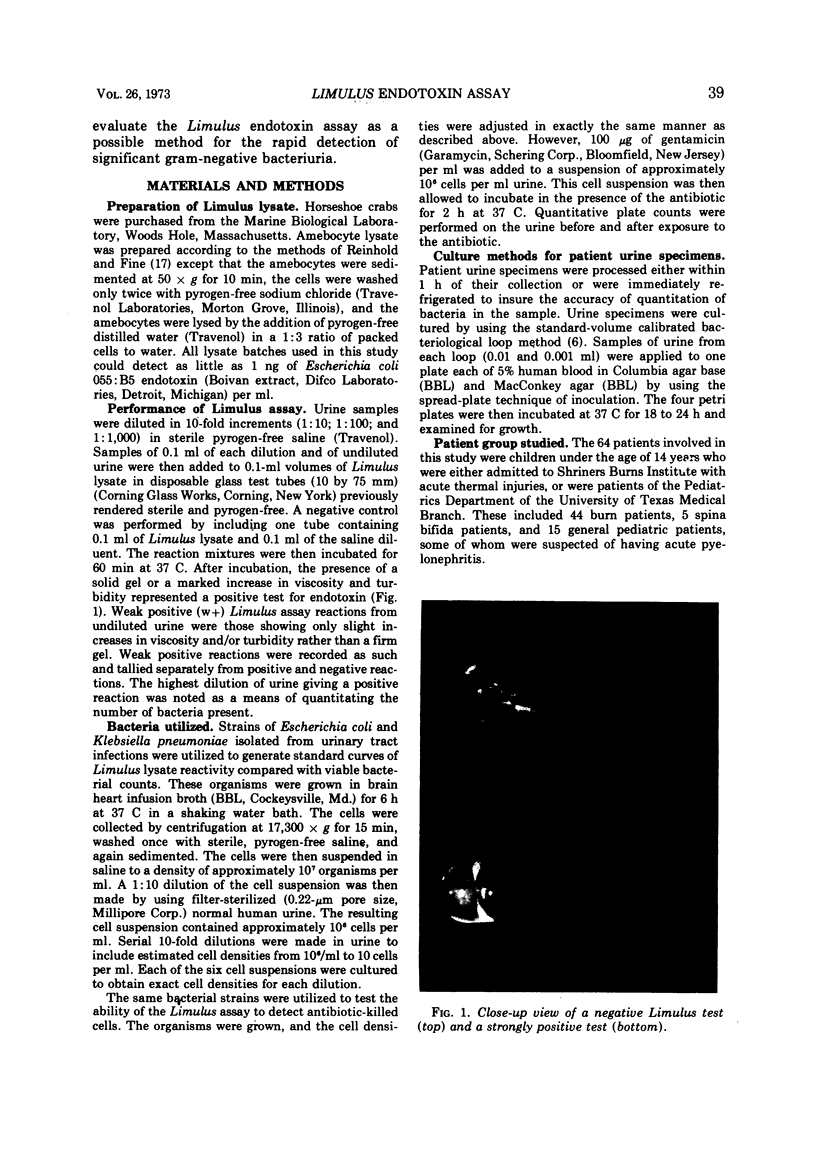
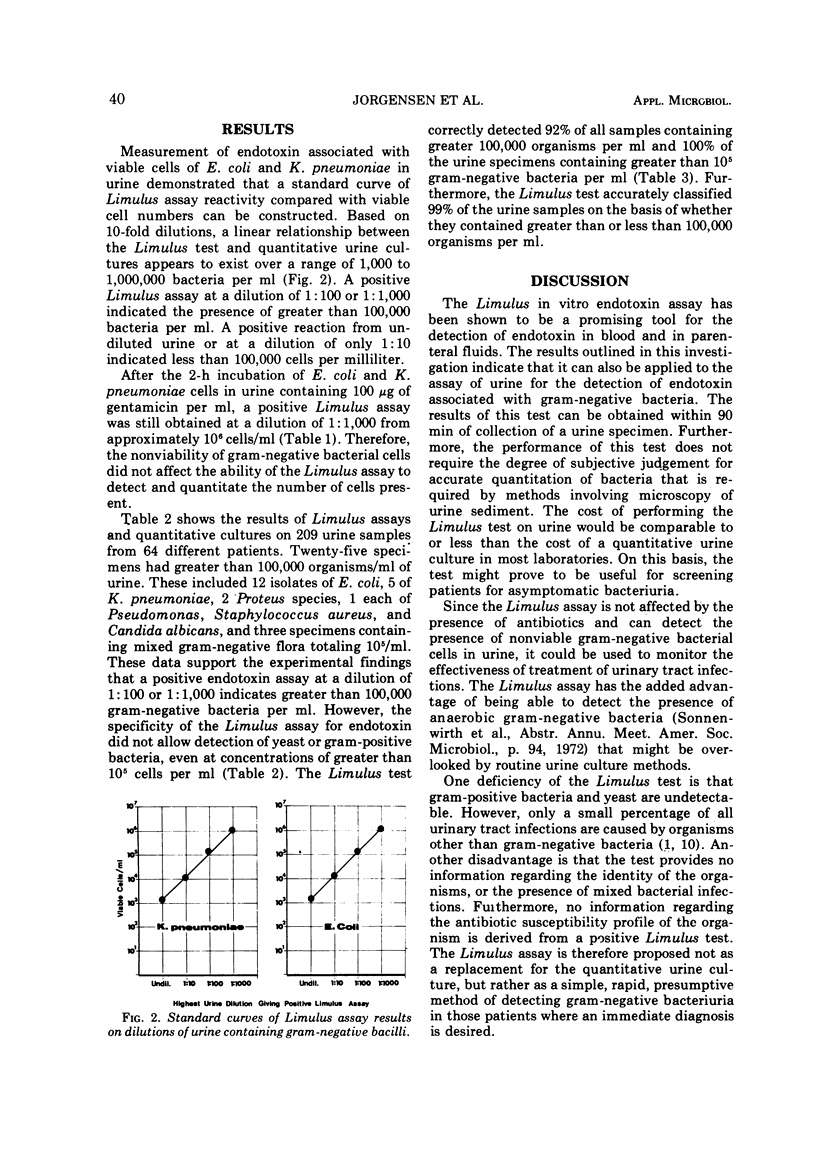
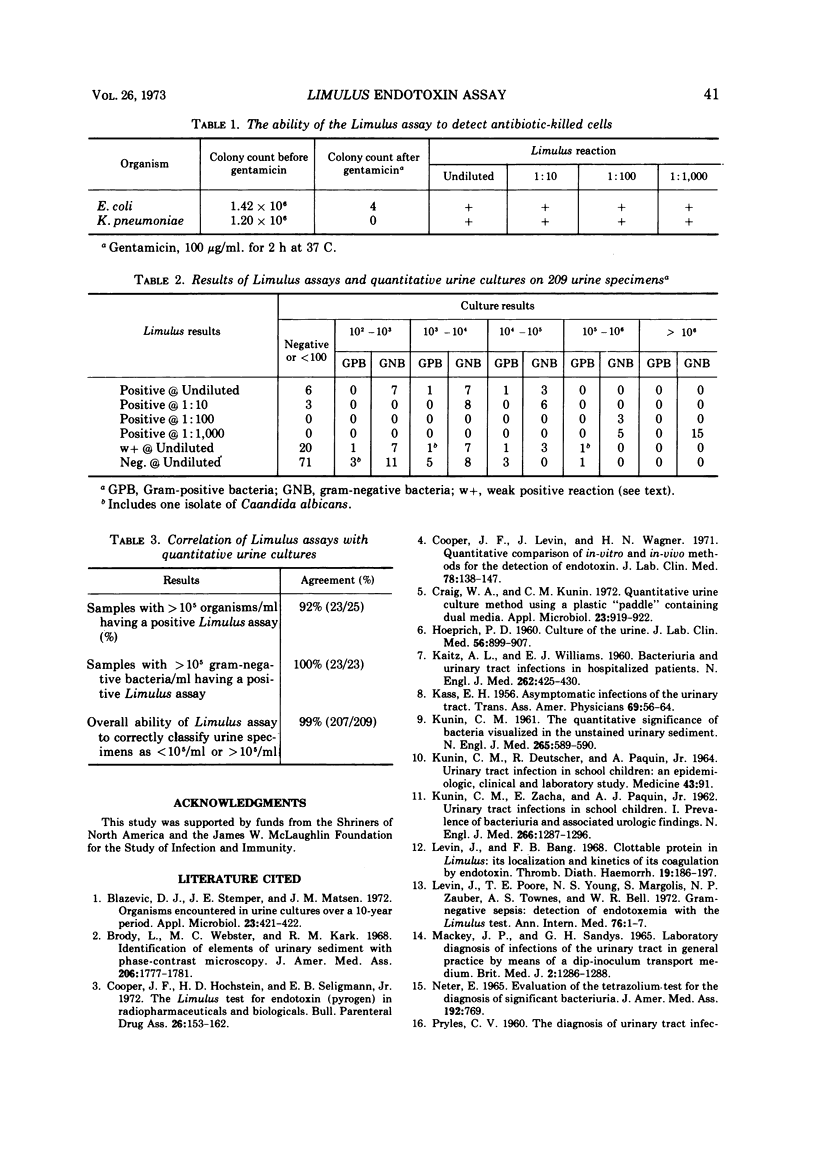
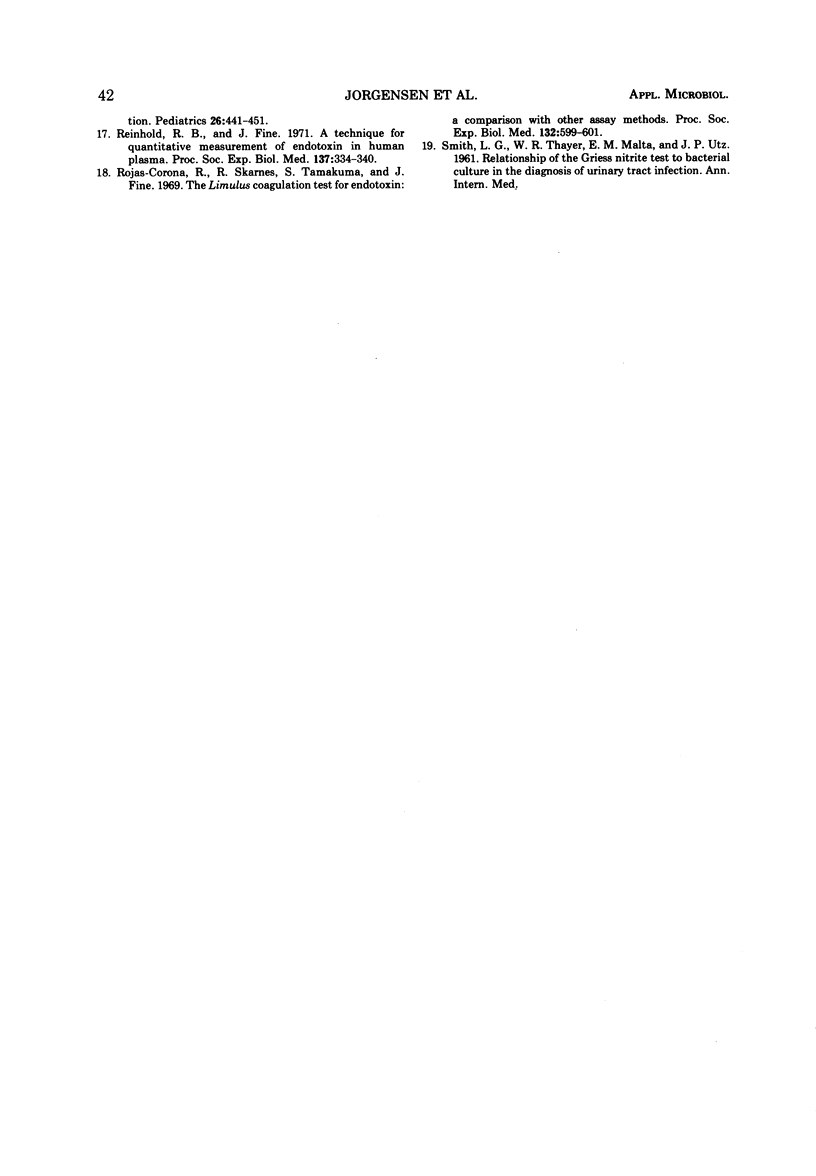
Images in this article
Selected References
These references are in PubMed. This may not be the complete list of references from this article.
- Blazevic D. J., Stemper J. E., Matsen J. M. Organisms encountered in urine cultures over a 10-year period. Appl Microbiol. 1972 Feb;23(2):421–422. doi: 10.1128/am.23.2.421-422.1972. [DOI] [PMC free article] [PubMed] [Google Scholar]
- Brody L., Webster M. C., Kark R. M. Identification of elements of urinary sediment with phase-contrast microscopy. A simple method. JAMA. 1968 Nov 18;206(8):1777–1781. [PubMed] [Google Scholar]
- Cooper J. F., Hochstein H. D., Seligmann E. B., Jr The Limulus test for endotoxin (Pyrogen) in radiopharmaceuticals and biologicals. Bull Parenter Drug Assoc. 1972 Jul-Aug;26(4):153–162. [PubMed] [Google Scholar]
- Cooper J. F., Levin J., Wagner H. N., Jr Quantitative comparison of in vitro and in vivo methods for the detection of endotoxin. J Lab Clin Med. 1971 Jul;78(1):138–148. [PubMed] [Google Scholar]
- Craig W. A., Kunin C. M. Quantitative urine culture method using a plastic "paddle" containing dual media. Appl Microbiol. 1972 May;23(5):919–922. doi: 10.1128/am.23.5.919-922.1972. [DOI] [PMC free article] [PubMed] [Google Scholar]
- HOEPRICH P. D. Culture of the urine. J Lab Clin Med. 1960 Dec;56:899–907. [PubMed] [Google Scholar]
- KAITZ A. L., WILLIAMS E. J. Bacteriuria and urinary-tract infections in hospitalized patients. N Engl J Med. 1960 Mar 3;262:425–430. doi: 10.1056/NEJM196003032620901. [DOI] [PubMed] [Google Scholar]
- KASS E. H. Asymptomatic infections of the urinary tract. Trans Assoc Am Physicians. 1956;69:56–64. [PubMed] [Google Scholar]
- KUNIN C. M., DEUTSCHER R., PAQUIN A., Jr URINARY TRACT INFECTION IN SCHOOL CHILDREN: AN EPIDEMIOLOGIC, CLINICAL AND LABORATORY STUDY. Medicine (Baltimore) 1964 Mar;43:91–130. [PubMed] [Google Scholar]
- KUNIN C. M. The quantitative significance of bacteria visualized in the unstained urinary sediment. N Engl J Med. 1961 Sep 21;265:589–590. doi: 10.1056/NEJM196109212651207. [DOI] [PubMed] [Google Scholar]
- KUNIN C. M., ZACHA E., PAQUIN A. J., Jr Urinary-tract infections in schoolchildren. I. Prevalence of bacteriuria and associated urologic findings. N Engl J Med. 1962 Jun 21;266:1287–1296. doi: 10.1056/NEJM196206212662501. [DOI] [PubMed] [Google Scholar]
- Levin J., Bang F. B. Clottable protein in Limulus; its localization and kinetics of its coagulation by endotoxin. Thromb Diath Haemorrh. 1968 Mar 31;19(1):186–197. [PubMed] [Google Scholar]
- Levin J., Poore T. E., Young N. S., Margolis S., Zauber N. P., Townes A. S., Bell W. R. Gram-negative sepsis: detection of endotoxemia with the limulus test. With studies of associated changes in blood coagulation, serum lipids, and complement. Ann Intern Med. 1972 Jan;76(1):1–7. doi: 10.7326/0003-4819-76-1-1. [DOI] [PubMed] [Google Scholar]
- Mackey J. P., Sandys G. H. Laboratory diagnosis of infections of the urinary tract in general practice by means of a dip-inoculum transport medium. Br Med J. 1965 Nov 27;2(5473):1286–1288. doi: 10.1136/bmj.2.5473.1286. [DOI] [PMC free article] [PubMed] [Google Scholar]
- NETER E. EVALUATION OF THE TETRAZOLIUM TEST FOR THE DIAGNOSIS OF SIGNIFICANT BACTERIURIA. JAMA. 1965 May 31;192:769–769. doi: 10.1001/jama.1965.03080220033007. [DOI] [PubMed] [Google Scholar]
- Reinhold R. B., Fine J. A technique for quantitative measurement of endotoxin in human plasma. Proc Soc Exp Biol Med. 1971 May;137(1):334–340. doi: 10.3181/00379727-137-35572. [DOI] [PubMed] [Google Scholar]
- Rojas-Corona R. R., Skarnes R., Tamakuma S., Fine J. The Limulus coagulation test for endotoxin. A comparison with other assay methods. Proc Soc Exp Biol Med. 1969 Nov;132(2):599–601. doi: 10.3181/00379727-132-34268. [DOI] [PubMed] [Google Scholar]



